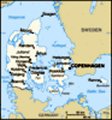Advertisement
Published: July 18th 2014
Odense on the island of Funen in Denmark - 16 July
After we left Horsens, it was raining, and in some patches, quite heavily. We drove over the Little Belt's Bridge from Jutland to Funen, and then about 10 kilometers south of Odense. At one of the fantastic roadside stops, we stayed the night. These stops have restaurants, WiFi, bathroom facilities, fuel and plenty of other people who stop for the night.
The next morning, we drove onto Odense. The great interest for us in Odense was the history of Hans Christian Anderson who was born in Odense and spent a lot of his childhood there.
Odense is in central Funen and has a population of about 172,000. It is the commercial hub of Funen, and has a notable shopping district with a diversity of stores. Several major industries are located in the city including the Albani Brewery and GASA, Denmark's major dealer in vegetables, fruits and flowers. The city is home to Odense Palace, erected by King Fredrick IV who died there in 1730, the Odense Theatre, and the Hans Christian Anderson Museum, situated in the house that was the birthplace of Hans Christian Andersen.
we
quickly found our bearings and headed for the H.C Anderson Museum. Remembered above all for his fairy tales, Hans Christian Andersen was born in Odense in 1805. It is thought his birthplace is the small yellow house on the corner of Hans Jensens Stræde and Bangs Boder in the old town. In 1908 the house was opened as the Hans Christian Anderson Museum. It documents his life from his childhood years as the son of a struggling shoemaker, to his schooling, career as an author, and later life, with artefacts providing an insight into his acquaintances and adventures.
Andersen's childhood home is on Munkemøllestræde not far from the cathedral. We visited this little house which was very interesting also. He lived in the little half-timbered house from the age of two until he was 14. Opened as a museum in 1930, the house contains an exhibition of the cobbling tools used by his father and other items based on Andersen's own descriptions.
Throughout the city we saw numerous statues and sculptures representing characters from the stories of Hans Christian Andersen. They include the Steadfast Tin Soldier, the Mermaid, the Shepherdess and the Chimney Sweep, the Toad, the Darning
Needle, the Emperor's New Clothes, the Sea Horse, the Paper Boat, the Flying Trunk and the Wild Swans. There is also a distinctive statue of Andersen in
Eventyrparken (The Fairy Tale Park) beside the cathedral. Sculpted in 1888, it shows the storyteller with a book in his hand, ready to entertain onlookers with his fairy tales. There was even one outside the Radisson Hotel which Tom found worth sitting down next to.
In the grounds of the Museum was also a castle where there was a performance put on for the children - who are all on summer holidays. The stories, we gathered, were of course based on the stories written by H.C. Anderson.
As we walked around the city, we learned that tourism is an important source of income for the city. In 2008 Odense Municipality was listed seventh in Denmark for turnover on tourism, reaching 1.6 million Danish kroner for the year. In 2011, Odense Zoo was Funen's most popular tourist attraction but we decided not to visit it.
We did however, visit St Alban's Church, built in the Neogothic style and consecrated in 1908, is the Roman Catholic church of Odense. Its steeple is
54 m high - impressive.
Next was the Odense's City Hall, with its medieval Italian look, was also impressive. Completed in 1883, it combines red masonry with sandstone decorations, stepped gables and a saw-tooth course. It stands on the site of a smaller building from 1480. In 1937 The tower over the main entrance was torn down in 1942 but was not rebuilt. As work was delayed during the war, the extension was not completed until 1955. In conjunction with Hans Christian Andersen's 200th anniversary in 2005, comprehensive renovation work was completed on the building's interiors, including the entrance halls, meeting rooms, banqueting hall and council chamber.
We saw the Odense Palace which was erected by Frederick IV, who died there in 1730. Now an administrative building, it stands on the site of
Sankt Hans Kloster, a 15th-century monastery which was transferred to the Crown in 1536. The main white Baroque wing with 13 bays was completed in 1723.
Until the beginning of the Danish industrial revolution, Odense was also the second-largest city in modern Denmark, but has in recent times been overtaken by Aarhus. From the 1960s Odense increasingly became a cultural hub, with
the establishment of a university in 1966 and the launching of trade shows, including the large Odense Congress Centre.
So overall, we found it very easy to find places in Odense and to make the most of our short time in the city.
We were now off to Copenhagen - very excited about that.
Advertisement
Tot: 0.082s; Tpl: 0.014s; cc: 13; qc: 24; dbt: 0.0423s; 1; m:domysql w:travelblog (10.17.0.13); sld: 1;
; mem: 1.1mb























